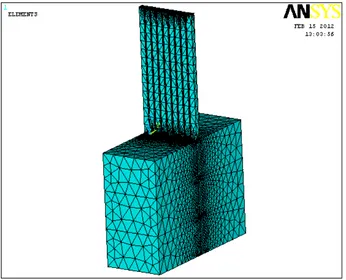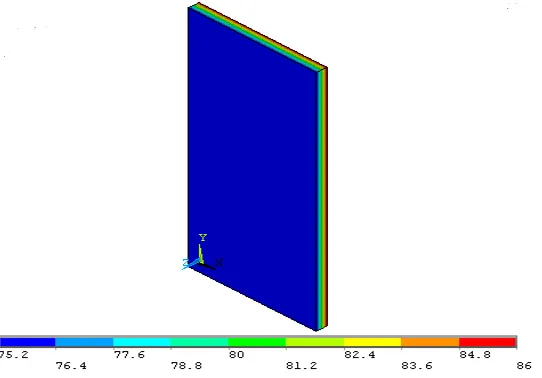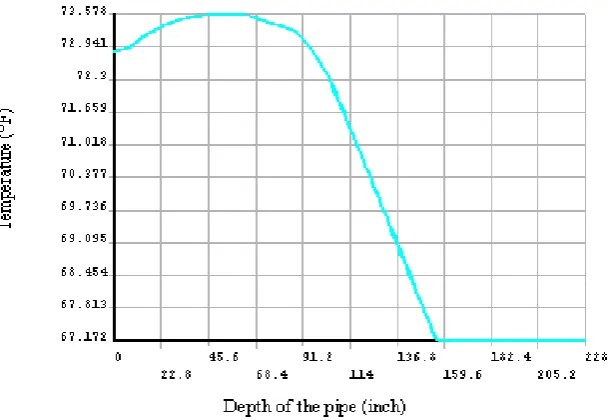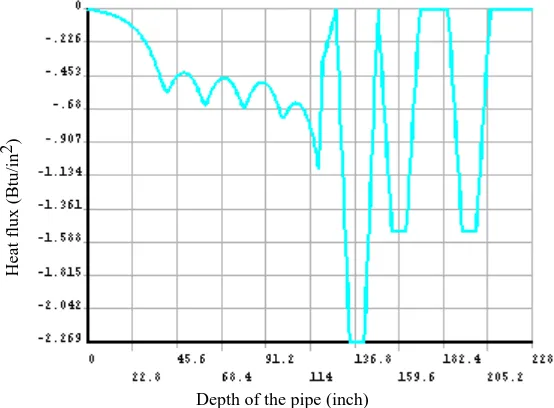ENERGY EFFICIENT GREEN BUILDING BASED ON GEO
COOLING SYSTEM IN SUSTAINABLE CONSTRUCTION OF
MALAYSIA
M.R. Alam1, M.F.M.Zain2 and A.B.M.A. Kaish3
1, 2, 3
Faculty of Engineering and Built Environment, Universiti Kebangsaan Malaysia, Selangor, Malaysia
*Corresponding E-mail : arabiul07@yahoo.com
ABSTRACT
This paper focuses geo energy based cooling of building in tropical country like Malaysia where temperature rises in daytime and goes beyond to a comfortable limit. In this study inside temperature of the room in daytime is considered to be reduced by adding thermal conductivity media inside the room elements such as walls through its connectivity to the underground soil where temperature is less than the ambient room temperature. Due to the underground connectivity of thermal conductivity media a flow of heat creates from the room to the underground soil and tries to produce a thermal balance between these two medias and therefore, room temperature drops to a temperature close to the underground soil temperature. Aluminium pipes are considered as high thermal conductivity material. The entire study is done numerically using ANSYS 11 finite element software to determine the role of underground soil and thermal conductivity pipes in cooling of building rooms. In numerical investigation heat flow between two systems (building rooms equipped with thermal conductivity pipe and underground soil) is studied and the performance of the conductivity materials is examined. The room temperature in the presence of thermal conductivity media as well as mechanical cooling system is also investigated in this study. It is seen that high thermal conductivity media plays a role in transferring heat from room to the underground soil and makes cooling of the building effectively. It acts also effectively when it uses with other mechanical cooling system of the building.
Keywords: Geo energy, heat flow, thermal conductivity pipe, underground soil,
mechanical cooling system
1.0 INTRODUCTION
Energy efficient building design is now a great concern among researchers and scientists as global energy demand is increasing gradually. Researchers have carried out researches regarding this issue in the last few years. Orientation, insulation of entire building envelope, WWR (window to wall ratio), double skin facades, high performance glazing, complete shading from direct sunlight, air-tightness and etc., were taken into consideration in their research interests for making building energy efficient.
with the shaded surface over the year at New Delhi, India. They found maximum soil temperature of 17.50C at that depth of wetted soil. Outdoor temperature (shown in Figure 1) under mixed dipterocarp forests of peninsular Malaysia for a typical day of July to August 2006 determined by Nik et al [6]. They mentioned that temperature of soil under forest cover is consistently lower than of the open air by 4 to 60C due to shading effect of forest cover. Cui et al [7] found out temperature variation with depth of underground soil for a typical day of tropical countries (see Figure 2). Therefore, it is seen that underground soil temperature always will be less than the ambient temperature of the building if there is no effect of natural heat sources. Variation of underground soil temperature is usually found up to a depth of 3 m thereafter, it becomes constant. However, it depends on several factors such as: thermal conductivity, density and specific heat, climate of surrounding environment (meteorological conditions, solar radiation intensity, wind speed, rain, humidity and the air temperature), any natural heat sources near the earth crust, etc.
Figure 1: Outdoor temperature under mixed dipterocarp forests of peninsular Malaysia for a typical day of July to August 2006 [6]
Figure 2: Temperature variation of underground soil with depth for typical days in Malaysia [7]
of the energy efficient cooltek house in Melaka, Malysia. Indoor, outdoor and inside the ground cooling air duct temperature, humidity and CO2 were measured in two modes of operations such as fully passive mode where ventilation is driven by the thermal pull of solar chimney and a hybrid mode where a small fan assists the solar chimney in ventilating the building. They mentioned that ground cooling system of inlet air helps to increase the energy efficiency of the house. Underground soil sometime also uses as heat sink for a modified air conditioner. Geothermal energy is also being used in other ways in heating and cooling of building such as Earth-air heat exchanger, Ground source heat pump, Bore hole heat exchanger, Energy piles, Ground absorbers, etc., in Germany, U.K, and other countries [9-11].
Temperature distribution inside the building is not constant during hot and cold time of day. It varies along vertically as well as horizontally inside of the room. Angela Simone and Carsten Rode [12] measure vertical and horizontal temperatures of the riso flexhouse room with different heating control principles. They found that the vertical temperature profile of the room shows notable temperature gradients, especially at the occupied zone when the solar gain is large, while otherwise the horizontal temperature distribution is smaller. They measured vertical temperatures at 1 m away from the window at heights of 0.1 m, 0.6 m, 1.1 m and 1.7 m above the floor from 8 am to 5 pm of a day. They found 30C to 50C vertical temperature variation in between 11.30 am to 2.00 pm. Yasui et al [13] carried our study on indoor thermal environment and vertical temperature gradient in large workshop with polycarbonate roofing of a school without air conditioning in summer time. They found large variation of vertical temperature inside the room. They mentioned that due to high solar radiation in summer and polycarbonate roofing system of the building indoor temperature becomes high and large vertical temperature gradient is formed. Pollard et al [14] found vertical temperature variation inside the room in between 0.50C and 1.50C for solar radiation in between 1 pm and 3 pm. Overby [15] also found similar variation of vertical temperature inside the room (shown in Figure 3).
Figure 3: Vertical variation of temperature inside the building room [15]
2.0 NUMERICAL MODELING OF HEAT FLOW SYSTEM BETWEEN THE
CONDUCTIVITY MEDIA AND THE UNDERGROUND SOIL MASS
This analysis is done to see the role of thermal conductivity media in cooling of the building. One room of a single story building is taken into consideration in numerical investigation of heat flow through the high thermal conductivity pipes into the underground soil. ANSYS 11 [16] general purpose finite element software was used to model the medias (conductivity media and underground soil) where heat flow was considered to be occurred. 8-noded linear thermal 3D solid elements (solid70) with one degree of freedom (DOF) at each node were used to discretize the entire systems. Temperature was defined at the air media inside of the room as well as underground soil. Temperature variation was considered within the underground soil of depth of 10 feet (according to Figure 2). In this depth temperatures were varied as 80.60F (270C) at zero depth, 75.20F (240C) at 3 feet depth, 71.60F (220C) at 6 feet depth and 680F (200C) at 10 feet depth. Thereafter, a constant temperature of 680F (20 0C) was assumed in higher depth (>10 feet) of underground soil. Pipe temperature was considered as same as room temperature. The trend of this temperature variation was obtained from the study of Overby [15] (see Figure 3). Overby carried out research on environment which is dominated by moderate temperature. However, in this study investigation was performed for the tropical countries like Malaysia where temperatures vary 260C to 320C in day time. From the literature it is seen that room temperature increases vertically from floor to ceiling along interior (center) of the room. A vertical variation (80.60F at 0 height, 82.40F at height 4 feet and 85.10F at height 7.5 feet and above) of room air temperature between room height of 0 ft and 7.5 ft was considered in this study. A square cross sectional hollow aluminum pipes (1 inch by 1 inch outer dimension with thickness of 0.125 inch) were taken into consideration for the simplicity of the analysis. At first single pipe with underground soil media was analyzed to see the heat flow of the room through the pipe. Since temperature around the pipe (on four sides of the pipes) is considered to be the same as air temperature of the room and material and geometry of the pipe all through the pipe length are also same therefore, only one quarter of the pipe (quarter symmetry advantage) is taken into consideration in modeling. The entire heat flow problem was considered as conduction and convection problem of heat transfer system. Conductivity/convection properties of different materials are given in Table 1. Steady state condition of heat flow into the system was taken into consideration in this study.
Table 1: Conductivity/convection properties of different materials [17]
Name of Materials Conductivity Coefficient (Btu/in.hr.0F)
Film Coefficient (Btu/in2.hr.0F)
Aluminum 12.05 -
Concrete 0.03 Soil (saturated sandy) 0.05 -
Air - 0.012
3.0 COMBINED EFFECT OF MECHANICAL COOLING SYSTEM AND
CONDUCTIVITY MEDIA ON THE COOLING SYSTEM OF THE
BUILDING PARAGRAPH
analyzed in the presence of underground soil and conductivity media. In this case, 10 feet depth of soil with variation of temperature was taken into consideration. Chiller cooling system with the cooling set point temperature of 75.20F (240C) was considered as mechanical cooling system in this study. This system was simulated through the removal of heat flux from the interior face of the wall for a temperature difference of 10.80F (60C). This technique was also applied in simulating the variable temperature of underground soil. Heat flux was calculated using the heat flux and the temperature gradient relationship (q = k ΔT/d, where q = heat flux, in Btu/in2, k = thermal conductivity coefficient, ΔT = temperature difference, d = thickness of the media). Outside air temperature due to sun radiation was considered as 860F (300C). Square cross sectional pipes were considered to be fixed with the inner surface of the C.C. wall at a spacing of 6 inch c/c. It was assumed that pipes temperature will be the same as the room temperature. The entire heat flow problem was considered as conduction and convection problems of heat transfer system. Thermal 3D solid (solid70) elements were used to discretize the entire system. Temperatures of the different mass medias (outside air temperature of the room and underground soil mass) were considered as the thermal load of the problem. Finite element discretization of the entire system is shown in Figure 4. The entire analysis was carried out for steady state condition of heat transfer problem.
Figure 4: Finite element discretization
4.0 RESULTS AND DISCUSSIONS
modeled with thermal conductivity pipes and mechanical cooling system. From this figure it is seen that temperature decreases with the depth of the pipe and along the inner surface of the wall. It is also seen that room temperature at the inner surface of the wall for this case is lower than those obtained for room condition modeled with mechanical cooling system alone (maximum temperature on the inner surface of the CC wall with thermal conductivity pipes and mechanical cooling system is 23.1 0C (73.580F) on the other hand inner surface temperature of the wall is 240C (75.200F) (from Figure 6) for CC wall with mechanical cooling system along. Due to fixing thermal conductivity pipes to the inner surface of the room wall in combination with mechanical cooling system, room temperature decreases by 1.70C (30F) (average value of temperature difference of pipe at top (0 inch depth -1.60C (2.860F)), at 45 inch depth (0.90C (1.620F)) and ground level (120 inch- 2.680C (4.820F)). Transverse temperature distribution along the width of the room wall is shown in Figure 8 for CC wall with thermal conductivity pipes and the mechanical cooling system. It is seen that pipe temperature is lower than the exterior wall temperature for room condition modeled with thermal conductivity pipe alone. In case of room conditioned modeled with thermal conductivity pipes and mechanical cooling system together it is seen that thermal conductivity pipe temperature is lower than the temperature of the inner surface of CC wall. This indicates that heat is flowing to the underground soil through the thermal conductivity pipes.
Figure 5: Variation of temperature (0F) with the depth (inch) of pipe (single pipe and underground soil mass)
Figure 7: Variation of temperature (0F) with the depth (inch) of pipe (CC wall with thermal conductivity pipes and mechanical cooling system)
Figure 8: Temperature (0F) distribution (transverse direction) along the interior side of the wall (CC wall with thermal conductivity pipes and mechanical cooling system)
Figure 9: Vector plot of heat flux (single pipe and underground soil mass)
Figure 10: Variation of heat flux (Btu/in2) with the depth of pipe (single pipe and soil mass)
When mechanical cooling system and thermal conductivity pipes were considered together in cooling system of the building room, heat flux variation was obtained much less than those obtained from the room condition modeled with thermal conductivity pipes alone. In this case significant temperature drop inside the room was obtained as illustrated in Figure 7.
5.0 CONCLUSIONS
From the numerical study carried out on heat transfer problem of different systems required for cooling residential/commercial low rise building it can be concluded that inside room
Depth of the pipe (inch)
Heat f
lux (B
tu/i
n
temperature of the building could be possible to reduce if rooms are constructed with high thermal conductivity media (pipes) in connection with the underground soil where temperature remains constant and less than the ambient room temperature. From the analysis it is seen that square shaped aluminum pipes are very effective in transferring heat from the interior of the room to the underground soil and underground soil acts as cooling reservoir for the building built in tropical environment. A temperature drop of 2.80C (50F) between top and ground level heights of the square shaped thermal conductivity pipes was found in this study. Heat flux was obtained more at a depth of 1 foot of the underground soil and its direction was obtained downward. This result gives an indication of heat flow through the pipes from inside of the room to the underground soil. When the thermal conductivity pipes are considered to be added to the mechanical cooling system of the building, higher cooling set point temperature could be fixed up for the cooling of the room of the building as conductivity pipes share to transfer the heat from room to the underground soil. If the thermal conductivity pipes and the mechanical cooling system are incorporated together higher cooling set point of mechanical cooling system could make building room comfortable and the energy required making cool of the building through mechanical cooling could take much less.
ACKNOWLEDGEMENT
This study was carried out under the funding of Faculty of Engineering and Built Environment, Universiti Kebangsaan, Malaysia (UKM), Bangi, Selangor D.E., Malaysia
REFERENCES
[1] Kasuda. T and Archenbach. P.R (1965), “Earth Temperature amd Thermal Diffusivity at Selected Stations in the United States”, ASHRAE Transactions, Vol. 71 (1)
[2] Crawford. C.B and Legget. R.F (1937), “Ground temperature investigations in Canada”, Research paper no. 33 of the division of building research, Reprinted from the engineering journal, Vol 40 (3)
[3] Florides. G and Kalogirou. S (2004), “Annual ground temperature measurement at various depths, Higher Technical Institute, P.O. Box 20423, Nicosia 2152, Cyprus (ktisis.cut.ac.cy/bitstream/10488 /870/1/C55-PRT020-SET3.pdf)
[4] Nassar. Y, ElNoaman. A, Abutaima. A, Yousif. S and Salem. A (2006), “Evaluation of the underground soil thermal storage properties in Libya”, Renewable Energy, Vol 3 (5), 2006, pages: 593-598.
[5] Bansal. N.K, Sodha. M.S, Bharadwaj. S.S (1983), “Performance of earth air tunnels”, Energy Research, Vol.7, New Delhi: Wiley; pages: 156
[6] Nik. A. R, Kasran. B and Hassan. A (1986), “Soil Temperature Regime under Mixed Dipterocarp Forests of Peninsular Malysia”, Partanika, Vol 9 (3), pages: 277-284
[7] Cui. W., Liao. Q., Chang. G., Chen. G., Peng. Q. and Jen. T.C. (2011), “Measurement and prediction of undisturbed underground temperature distribution”, Proceedings of the ASME 2011 International Mechanical Engineering Congress & Exposition IMECE2011, Denver, Colorado, USA.
[8] Reimann. G, Boswell. H and Bacon. S (2007), “Ground cooling of ventilation air for energy efficient house in Malaysia: a case study of the cooltek house”, Conference on Sustainable Building, Southeast Asia.
[9] Culver. G and Lund. J. W (1999), “Down hole heat exchanger”, Geo-heat Center, GHC Bulletin, pages: 1-11
[10] Lund. J.W (2007), A report on heat exchanger, Geo-heat Center, Oregon Institute of Technology
[12] Simone. A and Rode. C (2009), “Temperature distribution in riso flexhouse room with different heating control principle”, Technical report, Department of Civil Engineering, DTU Civil Engineering-Report SR-09-07 (UK)
[13] Yasui. S, Yamanaka. T, Sagara. K., Kotani. H, Momoi. Y and Yamada. J. (2010), “Indoor thermal environment and vertical temperature gradient in large workshop of school without air conditioning”, Report, Dept. of Architectural Eng., Osaka University, Suite 565-087, Osaka, Webpage link: server-labo4.arch.eng.osaka-u.ac.jp/~serverlabo4/.../10-i-16.pdf
[14] Pollard. A, O’Driscoll. R and Pinder. D.N (2001), “The impact of Solar Radiation on the Air Temperature within a residential building”, International Solar Energy Society 2001, Solar World Congress, Adelaide.
[15] Overby. H. (1994), “Measurement and calculation of vertical temperature gradients in rooms with convective flows”, ROOMVENT 94, 4th International Conference on Air Distribution in Rooms, Cracow, Poland.
[16] ANSYS 11.0 (2007), ANSYS Inc., South Point, Canonsburg, U.S.A
![Figure 2: Temperature variation of underground soil with depth for typical days in Malaysia [7]](https://thumb-us.123doks.com/thumbv2/123dok_us/8449295.1704437/2.595.184.427.472.692/figure-temperature-variation-underground-soil-depth-typical-malaysia.webp)
![Figure 3: Vertical variation of temperature inside the building room [15]](https://thumb-us.123doks.com/thumbv2/123dok_us/8449295.1704437/3.595.151.468.431.648/figure-vertical-variation-temperature-inside-building-room.webp)



